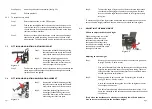
Brake Clamp
Transit Axle Block
Position
Figure 3.7.3
Figure 3.8.1
Figure 3.8.2
Figure 3.8.3
Standard
Fr
on
t o
f C
ha
ir
Antitipper
Wheel mounting
Bracket
M5 Nut and Bolt
Amputee
Wheel mounting
Bracket - Standard
Mount
Step 3: Use the larger bottom hole on
the block (see fig 3.3.3) to mount
the transit wheel. The block
should be pointing towards the
ground with the flat side of the
block facing outwards away from
the frame.
3.8
CHANGING FROM STANDARD CONFIGURATION TO AMPUTEE
SETTING
Step 1: Remove hangers, quick-release
wheels and axles. Place
wheelchair on bench/table or
floor as shown in figure 3.8.1.
Step 2: Remove the two M6 nuts and
bolts with a 5mm allen key and
10mm spanner (as supplied in
Karma tool kit).
Step 3: Reposition wheel mounting
bracket as required. Replace
bolts, washers and nuts and
tighten. Replace quick-release
wheels, loosen brake clamps with
a 5mm allen key and slide along
frame to suit new wheel position.
HANDY HINT: Work on one side at a time so the other side can be used as
reference for correct brake positioning.
NOTE:
If changing from amputee setting back to standard configuration
move the brake before replacing the quick-release wheels.
the user can place their feet upon them.
Step 5:
Release the brakes.
CAUTION:
Never stand on the footplates when getting into or out of the
wheelchair.
Always ensure that the front castors are in line with the rear wheels and pointing
forwards and that the back of the wheelchair is secure against either a wall or firmly
held by an attendant.
2.2.2
Getting out
Step 1:
Make sure that the wheelchair is as close as possible to the transfer
point.
Step 2:
Back the wheelchair sufficiently to ensure that the castors are
pointing forward i.e. in line with the rear wheels and usually with the
castor forks pointing forward. Ensure that where possible the rear of
the wheelchair is against the wall or, if not, it must be firmly held by
an attendant.
Step 3:
Engage both the brakes.
Step 4:
Lift up the footplates and swing the footrests to the side.
Step 5:
Slide forwards on the seat.
Step 6:
Place one foot firmly on the ground with the knee at right angle and
the other foot slightly apart and further back.
Step 7:
Place your hands on the front of the armrests and moving your
weight forward, bring your head and shoulders up over your knees as
you push yourself up.
CAUTION:
Never stand on the footplate when getting out of or into the
wheelchair.
2.3
TRANSFERS
The following instructions apply to users with sufficient mobility to get in and out of
the wheelchair without assistance. However the instructions are still valid where
assistance is required and will help where other aids such as transfer boards or hoists
are used. Before transferring to or from the wheelchair, make sure you are as near as
possible to your point of transfer and that the brakes are applied.
Page 4
Page 11
4.
MAINTENANCE
4.1
CLEANING AND TYRE CARE
4.1.1
Cleaning
Clean the upholstery with a biological cleaning agent such as is recommended for
cleaning kitchen work surfaces. Do not use any propriety cleaning fluids as these may
damage the upholstery. Clean chrome and painted surfaces with a wax polish spray
or simply wipe over with a clean soft duster.
4.1.2
Tyres
The KM8000 manual wheelchair is fitted with a maintenance free castor and 12 ½” x
2 ¼” pneumatic rear tyre (transit wheelchair) or a 24” x 2 ¼” pneumatic rear tyre
(self-propelling wheelchair). It is advisable to check the air pressure of these
components every two weeks. This can be done either at a service station or with a
standard bicycle pump.
4.2
MAINTENANCE CHECKS
Every week check the following items for damage or excessive wear:
Upholstery and occupant restraints where fitted.
Every month examine the following items for effective operation e.g. damage and
general wear and tear:
Seat and backrest cushions
Armrest latch lever and clamp handle
Armrest pads
Brakes
Antitippers
Castors for free rotation of castor wheel and castor unit
Tyre tread depth
For repairs, please contact your service contractor.
2.1.3
Footrest Adjustments
Footrest Removal and Refitting
To remove the footrest push/pull the release lever and rotate the footrest until it faces
outwards. To lift off, pull upwards.
To refit, locate the footrest unit onto the frame lugs (at about 90 degrees to the side of
the frame) and rotate it inwards until the unit locks into place (you will hear a click).
CAUTION:
The occupant's leg must be supported or resting safely, while
executing the above adjustments.
To adjust footplate height
Step 1:
To adjust footplate height, use tool
provided to loosen the bolt at the
bottom of the footrest stem.
Step 2:
Adjust to the required height and
retighten.
2.1.4
Antitip bars for wheelchair
NOTE: For the users safety, these must be fitted.
To fit: Depress rear location button on the antitip bar
and slide into rear of frame tube. The front button
MUST engage through the hole in the frame. Check
antitip is secure by attempting to push backward and
forward. Follow these instructions to fit the atnitip bar
on the other side of the wheelchair.
2.2
GETTING IN AND OUT
2.2.1
Getting in
Step 1:
Engage both brakes.
Step 2:
Lift up the footplates and swing footrest to the side.
Step 3:
The user should now lower themselves into the seat using the
armrests as supports (if possible).
Step 4:
Push the footplates back down and re-locate the footrests so that
Page 3
Page 12



























